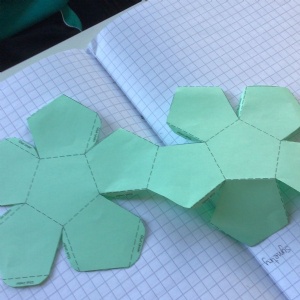Published on 07/10/22

Geometry is an area of mathematics, which includes both two-dimensional shapes and three-dimensional solids.
One thing students need to be able to do is to form an understanding of how a two-dimensional net can be used to construct a three-dimensional solid, which has faces, vertices and edges.
Last year (2021), for enrichment, the students in 7A were given nets for the five Platonic solids (tetrahedron, cube, octahedron, dodecahedron and icosahedron), which is a special set of polyhedra, where all the faces are regular polygons with the same shape and size. The students then set about constructing them, as shown in the photos.
One question the students were asked was why there are only five Platonic solids (they had enough knowledge at this stage through their studies on angles to be able to explain this), and the next thing they were asked to explore was the relationship between the number of faces, vertices and edges for each Platonic solid.
There is a special formula, Euler’s formula, which relates to polyhedra. Having made the Platonic solids, the students were asked to count the number of faces, vertices and edges for each one, and then tabulate the numbers accordingly to see if they could find Euler’s formula.
For the mathematically curious, see, for example, https://www.mathsisfun.com/platonic_solids.htm
